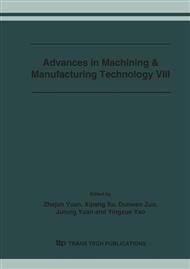p.108
p.113
p.118
p.123
p.127
p.131
p.136
p.140
p.145
Theoretical Analysis on the Machining Mechanism in Ultrasonic Vibration Abrasive Waterjet
Abstract:
As a unique machining way, Abrasive Waterjet Machining (AWJ) is one of the fastest developing new non-traditional machining methods and has a wide range of machinable materials. In this paper, the machining mechanism in AWJ is theoretically analyzed by impact dynamic mechanics method. There is stagnancy layer between waterjet and workpiece surface. It is found that the stagnancy layer and low energy abrasive particle are the main factors, which weaken machining capability and effective utilizing ratio of energy of AWJ machining. Ultrasonic Vibration Abrasive Waterjet Machining, a new machining method, is put forward and the influence of ultrasonic vibration on machining mechanism of AWJ machining is discussed.
Info:
Periodical:
Pages:
127-130
Citation:
Online since:
July 2006
Authors:
Price:
Сopyright:
© 2006 Trans Tech Publications Ltd. All Rights Reserved
Share:
Citation:


